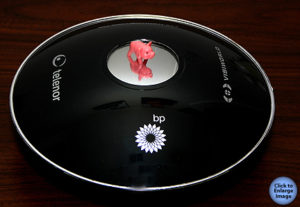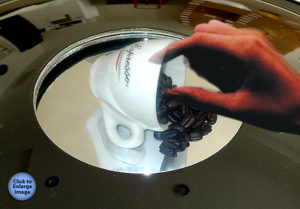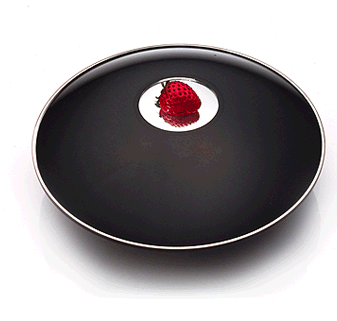What is a Hologram?
| Each Mirage® you display is a scientific phenomenon called a three-dimensional real image. For decades, students often first heard of them in science labs, but very few actually saw one. The most popular demonstration, when available, was a single parabolic mirror setup that looked something like this:
A startling surprise for the senses. Indeed, Mirage® is capable of fooling anyone. Even with nothing in it, people are amazed when they touch the mirrored circle…their fingers go right through it. And when you place an object inside, nothing about the appearance of Mirage®will suggest that the object is not actually resting where they see it, before their eyes – until grasping and groping fingers prove there’s nothing there but thin air! You’ll also notice that objects which are reversed in a single mirror are reversed back again in your Mirage®, so that the illusion is “right reading,” virtually identical to the original. Achieving this breakthrough in three-dimensional real imagery requires critical manufacturing tolerances. The basic principal, however, is simple. VIRTUAL IMAGES VS. REAL IMAGESMore or less than meets the eye. Two types of images exist in nature: real and virtual. A real image is one in which light rays actually come from the image. In a virtual image, they appear to come from the reflected image – but do not. In a flat mirror, for example, the virtual image of an object is behind, or “inside” the mirror, but light rays do not emanate form there. Real images form outside the system, where emerging light rays cross and are “caught”…inside camera…on a screen…or in a Mirage®. All concave mirrors can produce real images under certain circumstances. Conditions must be rigidly maintained, however, or the illusion fails to appear. Observe the path of light rays, below, as they construct a three-dimensional image of a marble:
MODERN HOLOGRAPHYNot too long ago, a new and exciting technology called holography began to capture public attention. Depth-defying images produced in common holography are created by laser photography. However, Mirage®’s 3-D illusions are not holograms formed by lasers. In an evolving science, Mirage®’s full-color effect is called a reflective hologram…a contemporary term for “any device which can reproduce the image of an object in full three-dimensional reality.” Our concept of reality is not innate. The illusions you create with your Mirage®…on a desktop, on a table, or in your hands…literally contradict a lifetime of experiences. Never has the line between sensory perception and reality been exposed with such startling clarity. DIRECTIONS FOR USING MIRAGE®Place any small object or objects in the lower mirror, taking care to center them. Use your imagination, almost any small object works well: a ring, strawberry, sugar cube, butterfly, marbles, coins, nuts and bolts, jelly beans, buttons, flowers, vitamins – you name it. Set the upper mirror on top. Instantly, the objects appear to be resting on the mirrored circle, in life like color and solid appearance. Shine a light on them. Look at them from all sides. But reach to touch them, and your fingers go right through. There’s nothing there but thin air! Again and again, people will refuse to believe that they can’t touch what they see before them. You’ve created a Mirage® that defies, yet demands, explanation. |
|


